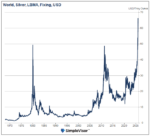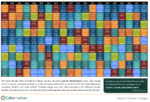Overview: The dollar is paring yesterday's advance that was spurred by the rise in US rates following the preliminary PMI, which reached its best level in two years. The survey also picked up higher prices. The dollar is in narrow trading ranges but softer against nearly all the G10 currencies today. The Swiss franc and Japanese yen are laggards. Despite a large disappointing miss on UK retail sales, sterling has steadied after falling yesterday for the first time in five sessions. The Dollar Index approached but did not take out the 20-day moving average (105.10), which it has held below since May 2. Emerging market currencies are mostly firmer, but Asian currencies are underperforming central Europe, with the notable exception of the Indian rupee, which is up around 0.25% today. Lastly, the G7 communique is expected to be released tomorrow. There may be a reiteration of the stance on intervention: markets are best to determine exchange rates and intervention should be rare and aimed at addressing disorderly or volatile markets. The focus is likely on Ukraine funding and Russia's reserves, but a formal decision is not expected until next month's leaders' meeting.
Asia Pacific and European equities have sold off in the wake of yesterday's slide in the US. Many large markets in the Asia Pacific region, including the Nikkei, Hang Seng, CSI 300, South Korea, and Australia fell by more than 1%. Europe is faring better and is off almost 0.5% today to bring this week's loss to almost 0.75%. US index futures are slightly firmer. Asia Pacific bonds played catch-up after yesterday's Treasury sell-off. European benchmark 10-year yields are 1-2 bp lower today. The US 10-year Treasury yield is a little softer near 4.47%, leaving it up about three basis points on the week. The Fed funds futures show that the first cut is now pushed out to December, though there is still about an 85% chance of a cut in November, according to the current pricing. Gold has steadied after recording its two worst sessions of the year, during which fell by around 3.8%. July WTI is extending its losing streak to the fifth consecutive session today. It settled below its 200-day moving average (~$77.55) yesterday for the first time in three months, and is trading near $76.25, its lowest level since March.
Asia Pacific
Japan reported its national April CPI earlier today. The year-over-year pace moderated to 2.5% from 2.7%. The core measure, which excludes fresh food, eased to 2.2% from 2.6%. This is a three-month low. And the measure that excludes both fresh food and energy slowed to 2.4% from 2.9%, the slowest since September 2022. The market's reaction was rightly muted as the Tokyo CPI reported a few weeks ago pointed to this pullback. Moreover, Tokyo's May reading will be reported next week, and the headline and core rates are expected to bounce back. Still, the core and core-core measure that excludes fresh food and energy are expected to hold below 2%. Next week's Japanese data also includes April employment, retail sales and industrial production. The Japanese economy contracted in Q1 but already appears to have begun recovering and the April reports will likely provide more evidence. The timing of the BOJ moves may be data dependent, but Governor Ueda seems committed to normalizing monetary policy. Next week Australia report April retail sales and the monthly CPI. Regardless, the RBA is seen on hold for several months and the futures market does not anticipate a cut this year. There is much interest in China's new initiative to support property market but the conclusion from many foreign analysts it is too small. New EU tariffs on Chinese auto are expected to be announced next month. Beijing has already threatened to retaliate. China reports May PMI at the end of next week, and it is likely to confirm better activity. The composite PMI was at 50.3 at the end of last year and reached 52.7 in March before easing to 51.7 in April.
The continued rise in US rates encouraged the market to lift the greenback to JPY157.20 against the yen in North America yesterday, the highest level since May 1. It is in a tight range today of roughly JPY156.90-JPY157.15, helped by steadier US rates. As we have noted, the JPY157 area corresponds to the (61.8%) retracement of what appeared to be intervention-inspired losses after the greenback hit reached nearly JPY160.20 on April 29. There are options worth $2.7 bln at JPY157 that expire today. For fear of triggering another round of intervention, the market may turn cautious on an approach toward JPY158. The Australian dollar's recovery from Wednesday low slightly below $0.6610 fizzled in front of $0.6650. The bearish outside down day on Wednesday has not been negated. The Aussie was sold below to the 20-day moving average (a little above $0.6605) and closed below it for the first time this month. The 20-day moving average is slightly above $0.6610 today and the Australian dollar is flirting with it in the European morning. Some sales yesterday may have been related to the expire of options for around A$465 mln at $0.6605. today. Initial support may be near $0.6580, but there may be potential toward $0.6530-40. A move above $0.6640-50 would negate this bearish scenario. The PBOC set the dollar's reference at CNY7.1102 (CNY7.1098 yesterday and CNY7.1042 at the start of the week) as it continues to moderate the downside pressure on the yuan. The average in Bloomberg's survey was CNY7.2486 (CNY7.2462 yesterday). Against the offshore yuan, the dollar set a new high for the month, a little above CNH7.26. The high set last month was near CNH7.2830.
Europe
The eurozone has a light economic schedule through next week. The results of its trade investigations into China's practices are awaited and the European Parliament election (June 6-9) looms large. The UK's economic calendar also turns quiet after today's retail sales report. The UK markets are closed on Monday (Spring Bank Holiday), as are US markets (Memorial Day). May retail sales were tumbled by a dramatic 2.3% in April (and -2.0% excluding gasoline). The median forecast in Bloomberg's survey was for a 0.5% decline in the headline and a 0.8% decline excluding gasoline. Some narratives blamed the rainy weather (summer clothing and garden furniture purchases were weak, according to the British Retail Consortium) and others played up the risk of the early Easter distorting the seasonal adjustment. Still, it is the second consecutive month of less retail sales. In GDP terms, consumption rose in Q3 and Q4 23 but is off to a weaker start this year, even as the economy emerges from its brief and shallow recession.
The euro settled yesterday at a seven-day low slightly above $1.08. It set new session lows in US afternoon dealings. It has steadied today and reached the $1.0835 area in the European morning. Nearby resistance is seen in the $1.0840-50 area. The daily momentum indicators have turned lower, lending more credence to our suspicion that the month-long rally (mid-April-mid-May, or from $1.06 to almost $1.09) is over. The euro tested the low for the year against sterling (~GBP0.8500) and bounced and is trading near GBP0.8520-30 in Europe. Near-term potential may extended toward GBP0.8540-GBP0.8565. This also means that sterling, which has fared better than the euro against the dollar, may be poised for some catch-up. It ended a four-day streak where it closed above $1.27 yesterday. It was the first session in nine that sterling took out the previous session's low. There are options for nearly GBP310 mln that expire there today. Initial resistance may be encountered in the $1.2720-30 area. The momentum indicators are poised to turn lower.
America
The highlight today in the US is the preliminary durable goods report. Recall that March's strength was revised away. The 2.6% headline gain was revised to a still firm 0.9%, but the excluding aircraft and defense orders turned into a 0.2% decline from a 0.1% gain. Shipments were also revised to show a contraction. University of Michigan's preliminary consumer confidence survey will be reported, as well. Recall that it fell sharply in May (67.4 vs. 77.2). It was the largest drop since June 2022. Reports indicated that it changed to more internet-based surveys and some attributed it to the rise in inflation expectations (one-year to 3.5% from 3.2% and five-10-year to 3.1% from 3.0%). Canada reports March retail sales. Auto sales likely dragged down the headline rate, though this could be more a price issue than volume. The preliminary estimate by StatsCan was for a flat report. The contraction expected will be the third consecutive month of declining Canadian retail sales and the fourth in five months. Mexico is expected to report a small trade deficit in April (~-$600 mln) after a $2.1 bln surplus was reported in March. The March surplus was the second largest since February 2021.
The Canadian dollar was the weakest of the G10 currencies yesterday, losing nearly 0.3% and falling to its lowest level since May 8. The greenback approached the (61.8%) retracement of the decline from the April 16 high found near CAD1.3750. It is confined to a tight range (~CAD1.3720-40) so far today. Nearby resistance is seen in the CAD1.3785-CAD1.3800 area. The daily momentum indicators have turned up and a retest of the mid-April high (~CAD1.3845) cannot be ruled out. After setting a one-month low on Tuesday near MXN16.5280, the US dollar reversed higher and has settled stronger for the past three sessions. It approached pushed slightly through MXN16.75, where we had identified resistance. Even though the dollar has pulled back and is closer to MXN16.70, the move does not appear exhausted. The next target is MXN16.90, provided that support around MXN16.60 hold. Mexico's headline CPI did not fall as much as expected in the first half of May while the core rate increase matched expectations. The minutes from the recent central bank meeting underscored official caution. Sticky service prices and a strong labor market were cited. Still, some economists look for a rate cut next month, and the swaps market is consistent with a 25% chance. We had correctly anticipated the March cut but are less sanguine about a cut next month. Lastly, we note that Chile delivered the expected 50 bp rate cut yesterday, bringing the policy rate to 6.0%. It was at 11.25% when the easing cycle began last July. It was second consecutive meeting that the pace of cuts was reduced. The central bank signaled the cycle is not over. Inflation is running near 4%. The Chilean peso's nearly 7.8% rally over the past three months makes it the world's top performer.
Full story here Are you the author? Previous post See more for Next postTags: #USD,Chile,Currency Movement,Featured,Japan,Mexico,newsletter,U.K.,US
































